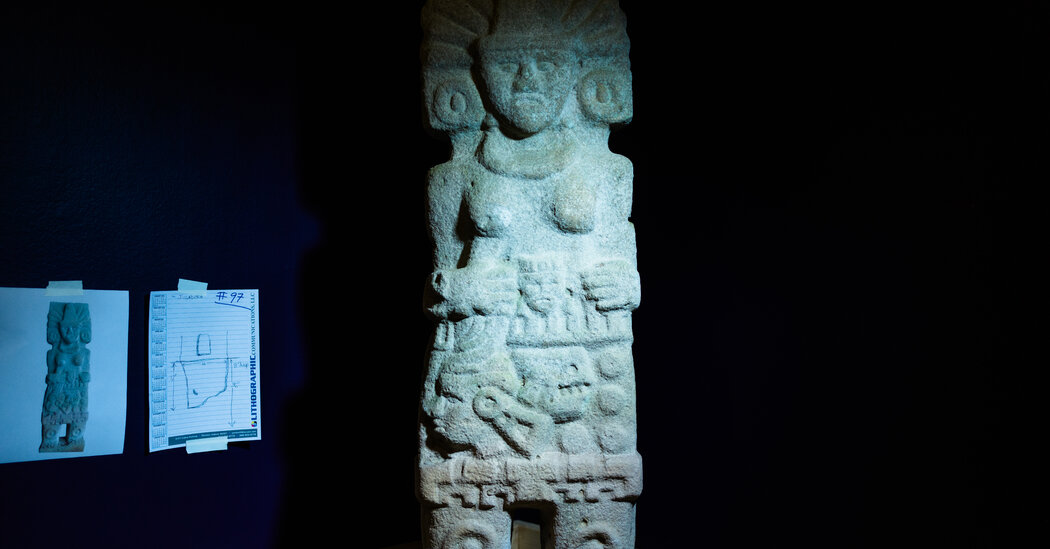The six-foot woman, carved in pale stone, wears a peaked headdress, circular earrings and the wide hip belt and kneepads of an ancient Mesoamerican athlete. Her expression is fierce, her pose triumphant. In her right hand, she grips the severed head of a sacrificial victim by the hair.
The sculpture is the first life-size representation of a ritual ballplayer found to date in the Huasteca, a tropical region spanning parts of several states along the Gulf Coast of Mexico.
Like virtually every other Mesoamerican society, the inhabitants of the Huasteca played what is simply known today as “the ballgame,” in the time before the Spanish conquest. Despite its name and ties to modern soccer, this game was more sacred rite than sport.
For the players, who bounce a solid, dangerously heavy rubber ball off their hips, it was a means of communing with the gods, one that sometimes culminated in human sacrifice.
The ballplayer will be among the most important artifacts in an exhibit, “Ancient Huasteca Women: Goddesses, Warriors and Governors,” at the National Museum of Mexican Art in Chicago, opening Friday. This is the first time the piece, which was discovered by landowners about 50 years ago near Álamo, Veracruz, has been on public display.
“A lot of people who study ancient Mesoamerica will be shocked when they see this piece,” said Cesáreo Moreno, the museum’s visual arts director and chief curator.
“It is a totally atypical sculpture,” said David Antonio Morales, an archaeologist with the National Institute of Anthropology and History in Veracruz, who stumbled upon it last November when he was visiting private collections.
He contacted María Eugenia Maldonado, one of the few archaeologists specializing in the pre-Columbian past of the Huasteca. At first, she didn’t think the figure could be real. It would be the first stone sculpture of a ballplayer found in the region, the first female ballplayer and the first at this scale holding a decapitated head.
“It’s putting all the elements into a single sculpture that had never been seen together before,” she said. “That is the importance of this sculpture.”
Kim N. Richter, a historian of pre-Columbian art at the Getty Research Institute in Los Angeles and an expert on female statues from the region, had not seen the piece. “It “would be really important because we don’t have any monumental sculptures of ballplayers in the Huasteca to date, male or female,” she said. “So that would be a huge discovery in itself.”
In the Classic Period (A.D. 200 to 950), “all we have are ceramic figurines that are about this big,” she continued in a video call, holding her hands about a foot apart. “They’re beautiful, they’re exquisite, but to have something in stone would be really remarkable.”
The piece has yet another unique element that Dr. Maldonado discovered as she sketched it. “I realized that below the head of the decapitated person there is a glyph that is possibly the name of the person whose head was cut off,” she said. Names took the form of a sign and a number signified by circles: It appears the individual was known as Four Death.
“It’s not an anonymous symbol of a sacrificial ritual,” Mr. Moreno said. “It is actually somebody who existed, a person whose head she’s holding.”
Dr. Maldonado says she hopes the exhibition, with 100 artifacts, will challenge what she calls “superficial” interpretations of women’s roles that have riddled scholarship of the region. For decades, archaeologists have described sculptures of men as individuals in positions of power, like priests or rulers. They’ve tended to brush aside sculptures of women as images of a fertility goddess.
“The sculptures that you find in most of the museums here in Mexico, they interpret these sculptures as the deity Tlazolteotl,” she said.
But Dr. Maldonado thinks there’s too much variety in the sculptures to represent a single character, One piece depicts a bare-breasted woman with intricate scarification on her chest and shoulders. Another, with wide eyes and parted lips, known as the Young Woman of Amajac, wears a long skirt, blouse and a headdress that cascades to either side, like a waterfall.
Compared to other Mesoamerican regions, the Huasteca has been neglected for a variety of reasons. In the 19th and 20th centuries, countless artifacts were excavated by oil prospectors and explorers, who sold or kept them without proper documentation.
In recent years, cartel violence has made excavations difficult. “People who had worked there for 40 years left and haven’t been back,” Dr. Richter said.
With limited funds, the archaeological priority has often been cultures that built the impressive stone pyramids that attract millions of tourists every year.
Dr. Maldonado says she hopes this exhibition will help promote scholarship on the Huasteca, and foster a sense of pride in its Indigenous inhabitants. She is taking lessons in Tenek, a regional language, which her teacher has told her the local children are increasingly ashamed to speak.
“I think this should also help people to see that somebody else, even outside of Mexico, is interested in their culture,” she said.
